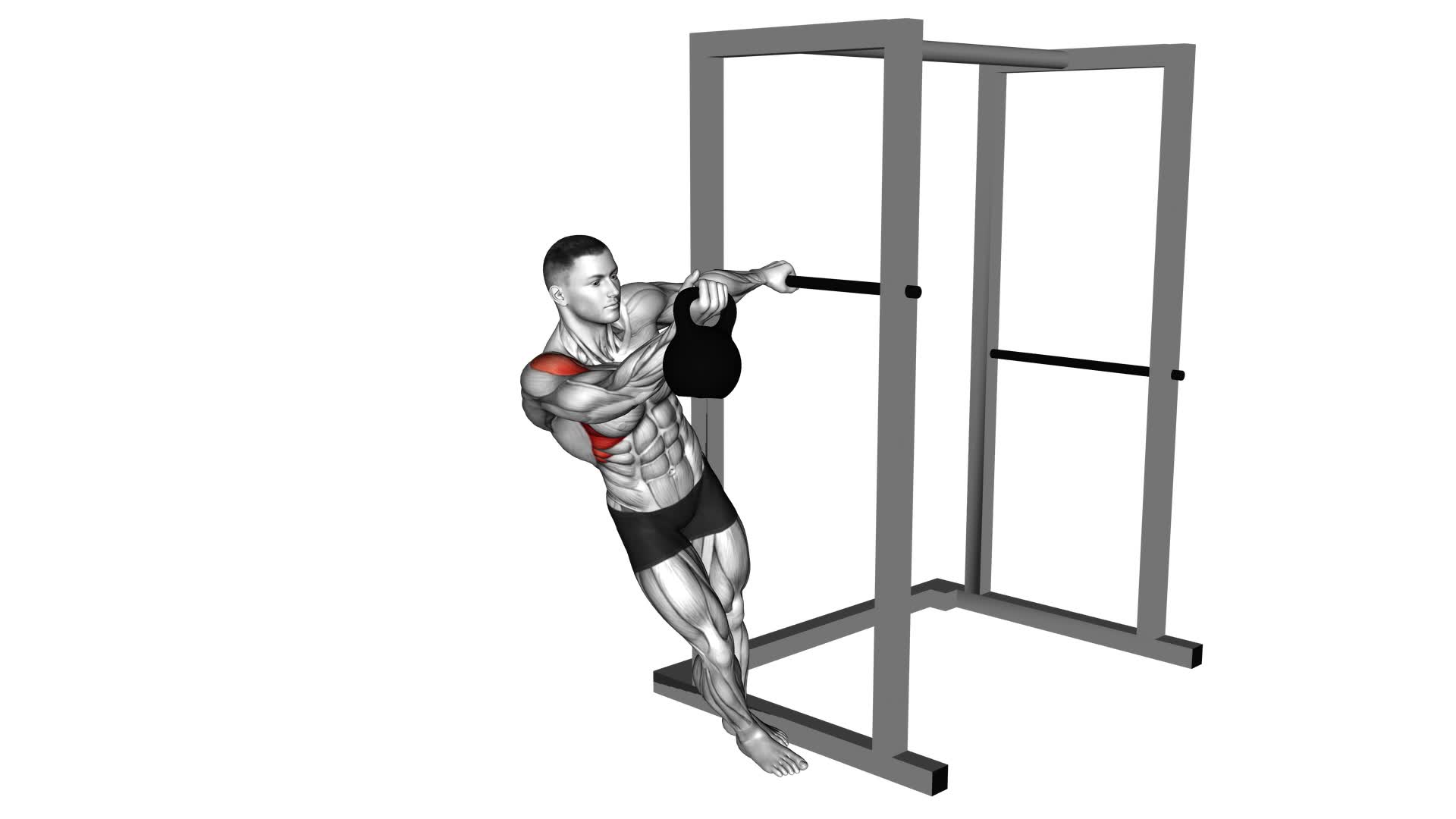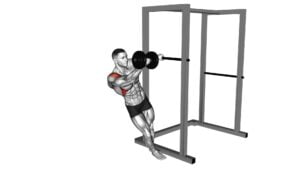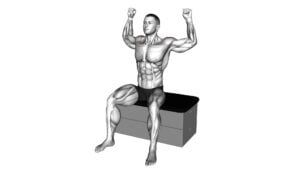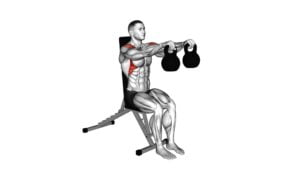Kettlebell Learning Front Raise (male) – Video Exercise Guide & Tips

Are you looking to improve your upper body strength and tone your shoulders? Look no further than the kettlebell learning front raise.
Watch This Exercise Video
In this video exercise guide, we'll walk you through the proper form and technique to maximize your gains and avoid common mistakes.
Plus, we'll share tips for increasing the difficulty and even provide a sample workout routine.
Get ready to take your fitness to the next level with this challenging and effective exercise.
Key Takeaways
- The Kettlebell Learning Front Raise improves upper body strength and shoulder stability.
- It engages multiple upper body muscles including the deltoids and trapezius.
- The exercise enhances performance in activities like weightlifting, swimming, and throwing.
- Variations and options for the exercise allow for targeting different muscles and adding variety to workouts.
Benefits of the Kettlebell Learning Front Raise
Improve your upper body strength and shoulder stability with the Kettlebell Learning Front Raise. This exercise offers numerous benefits for your shoulder strength and overall fitness. By engaging your deltoids, trapezius, and other upper body muscles, the Kettlebell Learning Front Raise helps to develop stronger, more stable shoulders. This can improve your performance in various activities that require upper body strength, such as weightlifting, swimming, and throwing.
In addition to the direct benefits to your shoulder strength, the Kettlebell Learning Front Raise also offers variations that can help you target different muscles and add variety to your workout routine. You can perform the exercise with different weights, starting from lighter kettlebells and gradually increasing the load as your strength improves. You can also try different grips, such as a neutral grip or an overhand grip, to challenge your muscles in different ways.
Proper Form and Technique for the Exercise
To ensure proper execution of the Kettlebell Learning Front Raise and maximize its benefits, follow these guidelines:
- Start by standing with your feet shoulder-width apart and holding the kettlebell in one hand, palm facing down.
- Keep your core engaged and maintain a slight bend in your knees throughout the exercise.
- Slowly lift the kettlebell in front of you, keeping your arm straight and parallel to the ground. Make sure to avoid any swinging or jerking motions.
- Pause at the top of the movement, then slowly lower the kettlebell back to the starting position.
- Repeat the exercise for the desired number of repetitions before switching to the other arm.
By following these guidelines, you can perform the Kettlebell Learning Front Raise with proper form and technique, which is essential for improving shoulder strength. This exercise targets the front deltoids and also engages the muscles in your upper back and core.
Variations of front raises include using dumbbells instead of kettlebells or performing the exercise in a seated or kneeling position. Remember to start with a light weight and gradually increase as you become more comfortable and confident with the movement.
Common Mistakes to Avoid
One common mistake to avoid when performing the Kettlebell Learning Front Raise is allowing your arm to swing or jerk during the exercise. This is a common mistake that many people make, but it can significantly reduce the effectiveness of the exercise and increase the risk of injury.
When you swing or jerk your arm, you aren't properly engaging the muscles that are targeted in this exercise. Instead, focus on using controlled movements and maintaining proper form throughout the entire range of motion. This will ensure that you're effectively targeting the muscles in your shoulders and upper back.
Another common mistake to avoid is using too much weight. It's important to start with a weight that's appropriate for your strength level and gradually increase the weight as you become stronger. Using too much weight can lead to improper form and increase the risk of injury.
Finally, make sure to keep your core engaged throughout the exercise. This will help stabilize your body and prevent any unnecessary movement or strain on your lower back.
Tips for Increasing the Difficulty of the Exercise
To increase the difficulty of the Kettlebell Learning Front Raise, you can try incorporating additional resistance or increasing the number of repetitions. Here are some tips for progressing in this exercise:
- Increase the weight: Gradually increase the weight of the kettlebell to challenge your muscles further. Start with a weight that allows you to perform the exercise with proper form and gradually work your way up.
- Change the grip: Switching to a more challenging grip can increase the difficulty of the exercise. For example, you can try using a pronated grip (palms facing down) instead of a neutral grip (palms facing each other).
- Add dynamic movements: Incorporating dynamic movements into the exercise can help increase the difficulty and engage more muscle groups. You can try performing the front raise while simultaneously performing a squat or a lunge.
Sample Workout Routine for Incorporating the Kettlebell Learning Front Raise
Now let's talk about how you can incorporate the Kettlebell Learning Front Raise into your sample workout routine.
To begin, it's important to choose the right kettlebell weight for this exercise. As a general guideline, it's recommended to start with a weight that allows you to perform 8-12 repetitions with proper form and without excessive strain. As you become more comfortable and proficient with the exercise, you can gradually increase the weight to continue challenging your muscles.
When it comes to workout variations, there are a few options you can consider.
One approach is to perform the Kettlebell Learning Front Raise as a standalone exercise, focusing on performing multiple sets and repetitions. This can help improve your shoulder strength and stability.
Another option is to incorporate the exercise into a full-body workout routine. For example, you can include it as part of a circuit training session, alternating between the Kettlebell Learning Front Raise and other exercises to target different muscle groups.
Remember to always warm up before starting your workout routine and listen to your body. If you experience any pain or discomfort, adjust the weight or range of motion accordingly. It's also recommended to consult with a fitness professional to ensure proper technique and form.
Frequently Asked Questions
Can Women Also Perform the Kettlebell Learning Front Raise Exercise?
Yes, women can also perform the kettlebell learning front raise exercise. There are modification options available to suit individual needs and abilities.
This exercise can be beneficial for women as it helps strengthen the shoulders, arms, and core. Incorporating kettlebell exercises into a women's fitness routine can enhance overall strength and improve posture.
It's important to start with lighter weights and gradually increase the intensity to avoid any potential injuries.
How Heavy Should the Kettlebell Be for Beginners?
When starting out with the kettlebell learning front raise, it's important to choose a weight that challenges you but doesn't compromise your form. For beginners, it's recommended to start with a lighter kettlebell, around 5-10 pounds. Focus on maintaining proper form and gradually increase the weight as you build strength and confidence.
Remember to engage your core, keep your back straight, and lift the kettlebell with control. Progression tips for beginners in kettlebell training include gradually increasing weight, mastering proper form, and listening to your body's limits.
Can the Kettlebell Learning Front Raise Help Improve Shoulder Flexibility?
The kettlebell learning front raise can be a great exercise for improving shoulder flexibility. By performing this exercise, you can target and strengthen the muscles in your shoulders, promoting increased range of motion.
To ensure proper form, start with a lighter kettlebell and gradually increase the weight as you become more comfortable. Remember to maintain good posture, engage your core, and lift the kettlebell with control.
With consistent practice, you can reap the benefits of improved shoulder flexibility.
Is It Necessary to Warm up Before Performing the Exercise?
It is important to warm up before performing any exercise, including the kettlebell learning front raise. Warming up helps to prepare your muscles and joints for the movement, reducing the risk of injury.
Additionally, proper form is crucial in this exercise to maximize its benefits. Incorporating kettlebell exercises into your workout routine can improve strength, stability, and overall fitness.
Are There Any Alternative Exercises That Target the Same Muscle Group as the Kettlebell Learning Front Raise?
If you're looking for alternative exercises that target the same muscle group as the kettlebell learning front raise, there are a few options you can try.
One option is the dumbbell front raise, where you hold a dumbbell in each hand and lift them in front of you.
Another alternative is the barbell front raise, where you hold a barbell with an overhand grip and lift it in front of you.
Both of these exercises are effective for targeting the same muscles as the kettlebell learning front raise.
Conclusion
Incorporating the kettlebell learning front raise into your workout routine offers numerous benefits, including improved shoulder strength and stability.
By maintaining proper form and avoiding common mistakes, you can maximize the effectiveness of this exercise.
To increase the difficulty, consider using a heavier kettlebell or adding more repetitions.
By following a sample workout routine, you can effectively incorporate the kettlebell learning front raise into your fitness regimen and achieve your desired results.

Author
Years ago, the spark of my life’s passion ignited in my mind the moment I stepped into the local gym for the first time. The inaugural bead of perspiration, the initial endeavor, the very first surge of endorphins, and a sense of pride that washed over me post-workout marked the beginning of my deep-seated interest in strength sports, fitness, and sports nutrition. This very curiosity blossomed rapidly into a profound fascination, propelling me to earn a Master’s degree in Physical Education from the Academy of Physical Education in Krakow, followed by a Sports Manager diploma from the Jagiellonian University. My journey of growth led me to gain more specialized qualifications, such as being a certified personal trainer with a focus on sports dietetics, a lifeguard, and an instructor for wellness and corrective gymnastics. Theoretical knowledge paired seamlessly with practical experience, reinforcing my belief that the transformation of individuals under my guidance was also a reflection of my personal growth. This belief holds true even today. Each day, I strive to push the boundaries and explore new realms. These realms gently elevate me to greater heights. The unique combination of passion for my field and the continuous quest for growth fuels my drive to break new ground.







